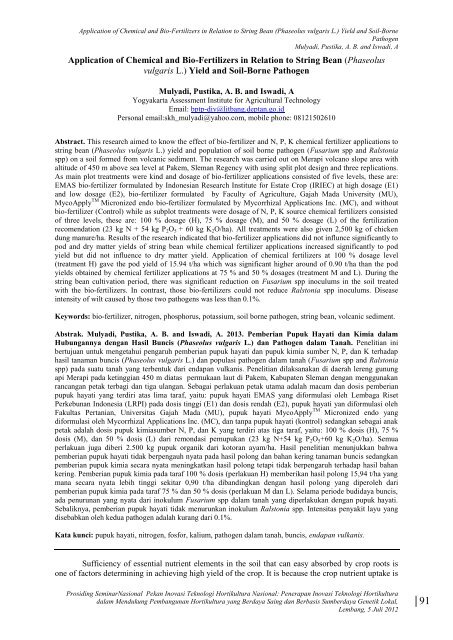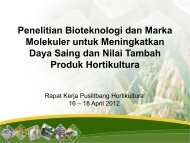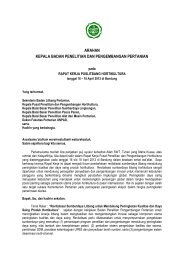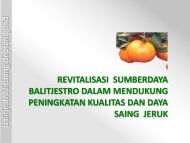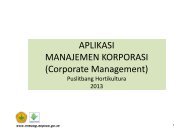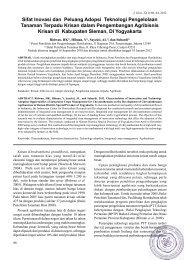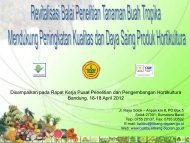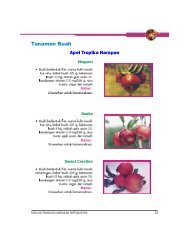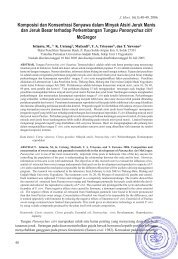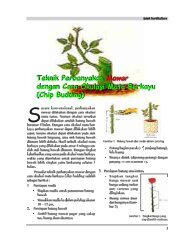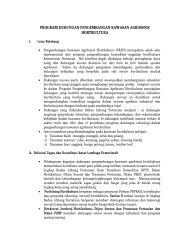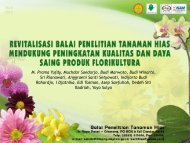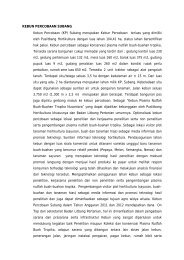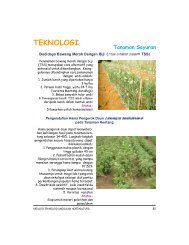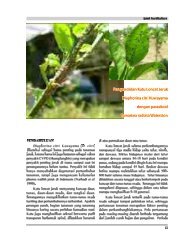SEMNAS Hortikultura Buku 2 - Departemen Pertanian
SEMNAS Hortikultura Buku 2 - Departemen Pertanian
SEMNAS Hortikultura Buku 2 - Departemen Pertanian
Create successful ePaper yourself
Turn your PDF publications into a flip-book with our unique Google optimized e-Paper software.
Application of Chemical and Bio-Fertilizers in Relation to String Bean (Phaseolus vulgaris L.) Yield and Soil-Borne<br />
Pathogen<br />
Mulyadi, Pustika, A. B. and Iswadi, A<br />
Application of Chemical and Bio-Fertilizers in Relation to String Bean (Phaseolus<br />
vulgaris L.) Yield and Soil-Borne Pathogen<br />
Mulyadi, Pustika, A. B. and Iswadi, A<br />
Yogyakarta Assessment Institute for Agricultural Technology<br />
Email: bptp-diy@litbang.deptan.go.id<br />
Personal email:skh_mulyadi@yahoo.com, mobile phone: 08121502610<br />
Abstract. This research aimed to know the effect of bio-fertilizer and N, P, K chemical fertilizer applications to<br />
string bean (Phaseolus vulgaris L.) yield and population of soil borne pathogen (Fusarium spp and Ralstonia<br />
spp) on a soil formed from volcanic sediment. The research was carried out on Merapi volcano slope area with<br />
altitude of 450 m above sea level at Pakem, Sleman Regency with using split plot design and three replications.<br />
As main plot treatments were kind and dosage of bio-fertilizer applications consisted of five levels, these are:<br />
EMAS bio-fertilizer formulated by Indonesian Research Institute for Estate Crop (IRIEC) at high dosage (E1)<br />
and low dosage (E2), bio-fertilizer formulated by Faculty of Agriculture, Gajah Mada University (MU),<br />
MycoApply TM Micronized endo bio-fertilizer formulated by Mycorrhizal Applications Inc. (MC), and without<br />
bio-fertilizer (Control) while as subplot treatments were dosage of N, P, K source chemical fertilizers consisted<br />
of three levels, these are: 100 % dosage (H), 75 % dosage (M), and 50 % dosage (L) of the fertilization<br />
recomendation (23 kg N + 54 kg P 2 O 5 + 60 kg K 2 O/ha). All treatments were also given 2,500 kg of chicken<br />
dung manure/ha. Results of the research indicated that bio-fertilizer applications did not influnce significantly to<br />
pod and dry matter yields of string bean while chemical fertilizer applications increased significantly to pod<br />
yield but did not influence to dry matter yield. Application of chemical fertilizers at 100 % dosage level<br />
(treatment H) gave the pod yield of 15.94 t/ha which was significant higher around of 0.90 t/ha than the pod<br />
yields obtained by chemical fertilizer applications at 75 % and 50 % dosages (treatment M and L). During the<br />
string bean cultivation period, there was significant reduction on Fusarium spp inoculums in the soil treated<br />
with the bio-fertilizers. In contrast, those bio-fertilizers could not reduce Ralstonia spp inoculums. Disease<br />
intensity of wilt caused by those two pathogens was less than 0.1%.<br />
Keywords: bio-fertilizer, nitrogen, phosphorus, potassium, soil borne pathogen, string bean, volcanic sediment.<br />
Abstrak. Mulyadi, Pustika, A. B. and Iswadi, A. 2013. Pemberian Pupuk Hayati dan Kimia dalam<br />
Hubungannya dengan Hasil Buncis (Phaseolus vulgaris L.) dan Pathogen dalam Tanah. Penelitian ini<br />
bertujuan untuk mengetahui pengaruh pemberian pupuk hayati dan pupuk kimia sumber N, P, dan K terhadap<br />
hasil tanaman buncis (Phaseolus vulgaris L.) dan populasi pathogen dalam tanah (Fusarium spp and Ralstonia<br />
spp) pada suatu tanah yang terbentuk dari endapan vulkanis. Penelitian dilaksanakan di daerah lereng gunung<br />
api Merapi pada ketinggian 450 m diatas permukaan laut di Pakem, Kabupaten Sleman dengan menggunakan<br />
rancangan petak terbagi dan tiga ulangan. Sebagai perlakuan petak utama adalah macam dan dosis pemberian<br />
pupuk hayati yang terdiri atas lima taraf, yaitu: pupuk hayati EMAS yang diformulasi oleh Lembaga Riset<br />
Perkebunan Indonesia (LRPI) pada dosis tinggi (E1) dan dosis rendah (E2), pupuk hayati yan diformulasi oleh<br />
Fakultas <strong>Pertanian</strong>, Universitas Gajah Mada (MU), pupuk hayati MycoApply TM Micronized endo yang<br />
diformulasi oleh Mycorrhizal Applications Inc. (MC), dan tanpa pupuk hayati (kontrol) sedangkan sebagai anak<br />
petak adalah dosis pupuk kimiasumber N, P, dan K yang terdiri atas tiga taraf, yaitu: 100 % dosis (H), 75 %<br />
dosis (M), dan 50 % dosis (L) dari remondasi pemupukan (23 kg N+54 kg P 2 O 5 +60 kg K 2 O/ha). Semua<br />
perlakuan juga diberi 2.500 kg pupuk organik dari kotoran ayam/ha. Hasil penelitian menunjukkan bahwa<br />
pemberian pupuk hayati tidak berpengauh nyata pada hasil polong dan bahan kering tanaman buncis sedangkan<br />
pemberian pupuk kimia secara nyata meningkatkan hasil polong tetapi tidak berpengaruh terhadap hasil bahan<br />
kering. Pemberian pupuk kimia pada taraf 100 % dosis (perlakuan H) memberikan hasil polong 15,94 t/ha yang<br />
mana secara nyata lebih tinggi sekitar 0,90 t/ha dibandingkan dengan hasil polong yang diperoleh dari<br />
pemberian pupuk kimia pada taraf 75 % dan 50 % dosis (perlakuan M dan L). Selama periode budidaya buncis,<br />
ada penurunan yang nyata dari inokulum Fusarium spp dalam tanah yang diperlakukan dengan pupuk hayati.<br />
Sebaliknya, pemberian pupuk hayati tidak menurunkan inokulum Ralstonia spp. Intensitas penyakit layu yang<br />
disebabkan oleh kedua pathogen adalah kurang dari 0.1%.<br />
Kata kunci: pupuk hayati, nitrogen, fosfor, kalium, pathogen dalam tanah, buncis, endapan vulkanis.<br />
Sufficiency of essential nutrient elements in the soil that can easy absorbed by crop roots is<br />
one of factors determining in achieving high yield of the crop. It is because the crop nutrient uptake is<br />
Prosiding SeminarNasional Pekan Inovasi Teknologi <strong>Hortikultura</strong> Nasional: Penerapan Inovasi Teknologi <strong>Hortikultura</strong><br />
dalam Mendukung Pembangunan <strong>Hortikultura</strong> yang Berdaya Saing dan Berbasis Sumberdaya Genetik Lokal,<br />
Lembang, 5 Juli 2012<br />
│91


